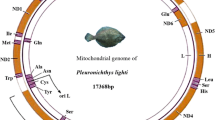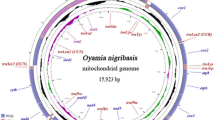Abstract
Mitochondrial cytochromeb genes of about 450 bp fragments from 3 proturan species, 5 collembolan species and 2 dipluran species have been sequenced. The number of nucleotide substitutions and Kimura 2-parameter distances have also been calculated, and a series of molecular phylogenetic trees reconstructed by using parsimony and distance methods. The proturan, collembolan and dipluran species have evolved monophyletic groups. The results suggest that Protura and Collembola are sister groups, while Diplura is more or less demonstrating a closer phylogenetic relationship to the pterygotan insects. The phylogeny and their systematic position of protura and other groups are also discussed.
Similar content being viewed by others

References
Yin, W. Y., Liang, A. P., On some hasic problems in Arthropod systematics,Acta Zootaronomica Sinica (in Chinese), 1998, 23(4): 337.
Yin, W. Y., A new idea on phylogeny of protura with appmach to its origin and systematic,Scientia Sinica, Ser. B, 1984, 27(2): 149.
Yin, W. Y., Xue, L. Z., Comparative spermatology of protura and its significance on proturan systematics,Science in China, Ser. B, 1993, 36(5): 575.
Kristmsen, N. P., Phylogeny of extant hexapods, inThe Insects of Australia, Vol.1, 2nd ed. (ed. Naumann, I. D.), Carlton: CSIRO, Melbourne Press, 1991, 125.
Kukalova-Peck, J., Fossil history and the evolution of hexapod structures, inThe Insects of Australia, Vol. 1, 2nd ed. (ed. Naumenn, I. D.), Carlton: CSIRO, Melbourne Press, 1991, 141.
Simon, C., Frati, F., Becckenbach, A.et al., Evolution, weighting, and phylogenetic utility of mitochondrial gene sequences anti a compilation of conserved polymerase chain reaction primers,Annals of the Entomological Society of America, 1994, 87(6): 651.
Rippe, R. M., Gellissen, G., The genes for cytochromeb, ND4L, ND6 and two tRNAs from the mitochondrial genome of the locust,Locusts migratoria, Curr. Genet., 1994, 25: 135.
Kurnar, S., Tamura, K., Nei, M.,MEGA: Molecular Evolutionary Genetics Analysis, Version 1.01, Univesity Park: Institutr of Molecular Evolutionary Genetirs of the Pennsylvania State University, 1993.
Felsenstein, J., PHYLIP(phylogeny inference package), Version 3.5c, University of Washington, 1993.
Irwin, D. A., Kocher, T. D., Wilson, A. C., Evolution of cytochromeb gene of mammals,J. Mol. Evol., 1991, 32:128.
Hennig, W.,Die Stammersgeschichter der Insekten, Frankfurt am Main: Waldemar Krammer. English edition with supplementary notes 1981: W. Hennig:Insert Phylogeny, New York: J. Wiley & Sons, 1969.
Kristensen, N. P., Phylogeny of insect orders,Ann. Rev. Ent., 1981, 26: 135.
Frati, F., Simon, C., Sullivan, J.et al., Evolution of the Mitochondria1 cytochrome Oxidase II gene in Collembola,J. Mol. Evol., 1997, 44: 145.
Author information
Authors and Affiliations
About this article
Cite this article
Shao, H., Zhang, Y., Xie, R. et al. Mitochondria1 cytochromeb sequences variation of Protura and molecular systematics of Apterygota. Chin. Sci. Bull. 44, 2031–2036 (1999). https://doi.org/10.1007/BF02884915
Received:
Issue Date:
DOI: https://doi.org/10.1007/BF02884915



